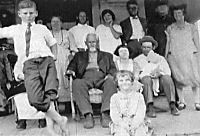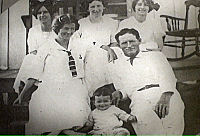|
|
|
The Families of Matagorda Island
|
|
|
|
The Hawes Family
|
|
|
|
Hugh Walker Hawes was born in Caroline County, Virginia in 1798
and at the age of twelve moved with his family to Kentucky.
As a young lawyer he went to New Orleans, Louisiana where he
joined the law firm of Judge Jean Dominique de Rion, whose only daughter he
married. Some time after 1833, Hugh Walker, with his wife, Marie Martha
Juliette and their two sons returned to Kentucky. There, in 1840, Marie
died after giving birth to their second daughter, who also died.
Hugh Walker Hawes first came to Matagorda Island, Texas from
Kentucky in 1839.
|

|
Hugh was a fairly wealthy man, for his time and by the mid
1800's had established a lucrative receiving and forwarding business on Saluria
Bayou, on the northeast end of Matagorda Island. He had built a large
warehouse and wharf where deep draft ships could unload their cargoes without
having to ply the shallow bay waters to their destinations. He also had
two steamships that made regular runs to New Orleans and had established a sheep
and cattle ranch, recognizing the big advantage of the Matalgorda Island grasses
and year-round grazing.
|
|

|
|
|
Around 1842, Hugh Walker Hawes married Corilla Calhoun, daughter
of Judge John C. and Mary (Morton) Calhoun of Kentucky. He began operating
between Kentucky and Texas, gradually increasing his holdings on Matagorda
Island. In 1853, he sold his Kentucky plantation on the Ohio River and
moved his family to Matagorda Island. His oldest son drowned in Matagorda
Bay in 1856.
The Civil War came and all improvements were ordered burned or
destroyed. His son served in the Confederacy as a Captain. After the
war ended, his fortune decimated, his home and improvements in ruins, he
regrouped and expanded his ranching operations. In 1866, a daughter died
of yellow fever. Hugh Walker Hawes died on Matagorda Island in 1883 and he
is buried there near his home site. A large white tombstone marks his
grave.
The Hawes family continued ranching on Matagorda Island, enduring
droughts, blizzards and several major hurricanes, sickness and deaths.
Some of them are buried there. A grandson of Hugh Walker Hawes died of
acute appendicitis while serving at the lighthouse on the island. A great
grandson died in his mother's arms at the age of four, on a sailboat trying to
reach a doctor.
|
|
|
After the death of Hugh Walker Hawes, the ranching operation on
the island continued until a devastating blow was dealt to the owners of all
property on the northeast 28 miles of Matagorda Island. A United States
marshal served papers on November 8, 1940 saying, "As of now this property
belongs to the United States government.
|

|
You have ten days to remove all
livestock and personal belongings". The family protested, hired lawyers
and offered to lease the land, but to no avail. Four years later they were
forced to accept approximately $7.00 per acre, improvements and all. If
they refused this court award, they lost their mineral estate, as well.
|
|
|
After WWII, the families sent numerous letters to the government
asking for the return of their property, as was assured by the Surplus Property
Act of 1944. The answer from the government was always that the family
would be notified when, and if, the property became surplus. It never
did. The property is now a part of the Aransas National Wildlife
Refuge.
The Hawes, Hill and Little families lost their Matagorda Island
homes and land to the United States government, after having survived
hurricanes, droughts, blizzards, and many other adversities.
|
|
| |
If you would like more information about this travesty of justice,
contact:
Forrest Hawes
302 Cannon Rd.
Victoria, TX 77904
email
|
|
| |
|
|
|
|
|
MatagordaIsland.com © 2006
All Rights Reserved
|
|
|